near Wisdom, Mont.
NPS Website; Local Website; Nez Perce NHP Website; Nez Perce NHT Website
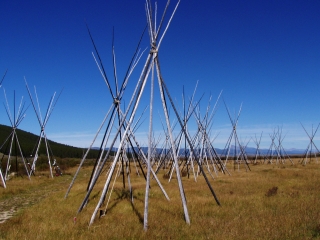 WHAT IS IT?
WHAT IS IT?Site of a major battle between the Nez Perce and the U.S. Army during Chief Joseph’s War of 1877. During the early portions of the battle, the U.S. Army massacred 60 Nez Perce seniors, women and children.
BEAUTY (5/10)
The Park’s deep beauty is belied by the troubling events of history that occurred here. The meandering North Fork of the Big Hole River moves through the beautiful Bitterroot Mountains covered with virgin pine trees.
HISTORICAL INTEREST (7/10)
Chief Joseph’s War of 1877 began as many Indian Wars began: reneged treaties and Gold. A Treaty, whose talks were initiated by the Nez Perce, was signed in 1855, giving the Tribe most of their ancestral homeland. Five years later, trespassing settlers found gold on the reservation and legal land rights were conveniently ignored. The United States drafted a new treaty in 1863, one that cut the Nez Perce land by 90 percent. Of course, finding Indian signatures proved difficult until the government approached the Nez Perce living on the 10 percent unaffected land. They signed their brethren’s birthright away creating two bands, the friendly “treaty band” and the hostile “non-treaty Nez Perce”.
The clashes became inevitable when the U.S. Army gave the non-treaty Nez Perce an ultimatum: get off the land or else. The non-treaty Nez Perce responded by killing 17 male settlers who had, history surmises, been involved in the killing of other Nez Perce. With fear of mass retribution, the entire non-treaty band, 800 members, moved southward. The U.S. Army followed. Skirmishes ensued at nearby Cottonwood, Clearwater and White Bird Canyon all with little Nez Perce loss and modest U.S. Army casualties.
The Nez Perce believed that if they could get out of the Idaho territory, then they would be safe from Army attacks. Big Hole was just across the border. The Nez Perce set up camp on the afternoon of August 7, 1877, most believing they were free from harm. At 3am on the 9th, during the pitch black night, the battle began.
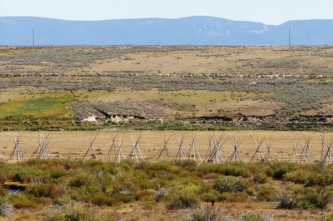 When it ended, 30 U.S. Army soldiers were dead, 30 Nez Perce warriors had perished and 60 Nez Perce women and children had been massacred. The Nez Perce continued eastward hoping to find refuge with the Crow. The Crow refused them sanctuary and they headed north to Canada. The U.S. Army caught them at Bear Paw, 40 miles south of Canada and 1,500 miles from where they had began. At Bear Paw, Chief Joseph surrendered with the famous words, “I will fight no more forever.”
When it ended, 30 U.S. Army soldiers were dead, 30 Nez Perce warriors had perished and 60 Nez Perce women and children had been massacred. The Nez Perce continued eastward hoping to find refuge with the Crow. The Crow refused them sanctuary and they headed north to Canada. The U.S. Army caught them at Bear Paw, 40 miles south of Canada and 1,500 miles from where they had began. At Bear Paw, Chief Joseph surrendered with the famous words, “I will fight no more forever.”The story of the Nez Perce flight, the slaughter of the innocents and the strength of a displaced people is poignantly told at Big Hole NB. The U.S. Army side is also represented. They were primarily recent immigrants, looking for the American dream, living in a unknown, dangerous and desolate place. Many of them, including the commanding officers did not agree with the Nez Perce containment policy. They were just doing their job.
All sides experienced great loss. This is a tragic, instructive incident in American history that cannot be forgotten.
CROWDS (8/10)
There was a surprisingly large crowd at Big Hole NB. Everyone was full of smiles and eager to learn. Judging from the comments in the Park registry book, most people had a good time and most came to a profound understanding of the historical situation. As it was with us, our knowledge was due to the terrific tours provided at the Site.
EASE OF USE/ACCESS (1/5)
Big Hole NB is very remote, located on the central portion of the Montana-Idaho border. The Site is 90 miles west of Butte and Interstate 15. If you approach from the north, it is 98 miles south of Missoula along scenic U.S. Route 93.
CONCESSIONS/BOOKSTORE (3/5)
The bookstore takes only a small portion of the Visitors Center. There is a small selection of books focused on Chief Joseph and the Nez Perce, and some modest handmade jewelry for sale. No spectacular items on display here.
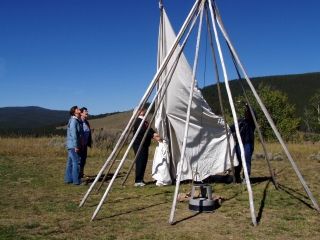 COSTS (3/5)
COSTS (3/5)Entry is $3 per person or $5 per vehicle. Admission is free with the National Parks Pass.
RANGER/GUIDE TO TOURIST RATIO (4/5)
There were three Rangers available to answer questions and give tours in the Visitor Center area. Ranger talks occurred non-stop during our visit. After the showing of the film, a Ranger asked us if we needed any further clarification. We were so overwhelmed by the film that we were in no state to talk to anybody, but it was nice of him to ask. Given the large crowd, there could have been more people on staff, especially because one of the Rangers was a few months pregnant.
There were no Rangers in the self-guided trail area, which was probably for the best. Those areas are best left for self-reflection.
TOURS/CLASSES (10/10)
All tours at Big Hole NB are tremendous. We spent three hours at the site, attended two Ranger talks, walked two self-guided trails, viewed the Park film and took in the Museum. No Site has been better at any of these separate parts. As a whole, the educational experience at Big Hole NB is nothing short of an American treasure.
We were especially moved by the self-guided trail through the Indian village. 89 teepee frames have been set up along the Big Hole River in their exact location on the morn of April 9. Small placards indicate the names of the people, Chief Jospeh, Looking Glass, White Bird, who camped in their respective teepee. You quietly wander through the village where the horrific slaughter of women and children occurred. You hear the screams, you hear the bullets, you feel the sorrow. It is a powerful experience. Small prayer offerings tied to several of the teepee frames remind a visitor that this event is real and relevant for the progeny of those who lost their lives here.
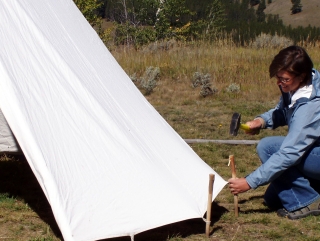 The Site’s Museum is equally understated and equally poignant. It is a small circular room whose walls are adorned with the pictures of those who fought at Big Hole and their quotes about their experience at the battle. The museum reminds you of the human side of war, the pain and reluctance to fight from both sides.
The Site’s Museum is equally understated and equally poignant. It is a small circular room whose walls are adorned with the pictures of those who fought at Big Hole and their quotes about their experience at the battle. The museum reminds you of the human side of war, the pain and reluctance to fight from both sides.The time at Big Hole NB was not all soul searching and deep thinking. One of our two Ranger talks was a teepee raising. As was customary, the women did all the work. Gab did a terrific job with the help of a pregnant Ranger!
FUN (7/10)
We arrived just in time for a Ranger Talk that summarized the Battle, making use of the Visitor Center’s vantage point above the Bitterroot valley to show us where and how everything took place. This talk lasted no more than 20 minutes and was presented simply enough so that even the younger kids in the group could fully comprehend that neither side came out a winner. The Ranger showed no bias in his explanation and allowed the audience of about 30 people to take in the landscape below them and the implications for both sides. It was excellent.
Although Gab was a reluctant participant, she did a fine job raising the teepee and dare we say, started to enjoy herself? She had the assistance of three older women and the pregnant Ranger. The husbands and the male Ranger, the same one who led the first Ranger talk, relaxed on the benches and urged their partners to get their work done faster. The good-natured joking from both sexes and the camaraderie of the home-makers made this event much more fun than we, particularly Gab, expected.
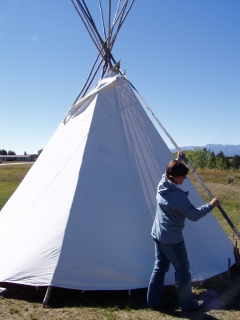 WOULD WE RECOMMEND? (8/10)
WOULD WE RECOMMEND? (8/10)With the exception of the teepee raising, this was a somber, quiet morning. One filled with reflection and discussion. The film at this site is probably the best we have seen so far. The diversity of the Rangers’ personalities, particularly the expecting younger woman and the older, more weathered ex-rancher, enhanced their ability to teach and as a result, our visit. It was a morning well-spent.
TOTAL 56/80
www.usa-c2c.com
© 2004-06